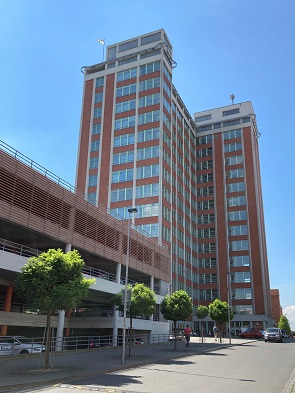
The Baťa skyscraper was also made famous by the director's mobile office
 |
The structure, designed by the architect Vladimír Karfík, was built in just two years from the laying of the foundation. It is reported that a skeleton of reinforced concrete for the skyscraper was constructed by 40 workers with four cranes in 160 days. One cannot be surprised by the speed; a proven Baťa module measuring 6.15 by 6.15 meters was used in the construction. The spaces between the columns were filled with bricks, and the building's exterior was clad with ceramic tiles. The building, which is not only tall but also 80 meters long and 20 meters wide, naturally blended in with other factory buildings in the city.
The first of more than 2000 officials of the Baťa conglomerate took their seats in the still under-construction building in May 1938 when the builders handed over the first three floors. They had access to the most modern technology of the time - from elevators to telephones to air conditioning. The concept of offices also advanced for its time; an entire floor was made up of a single large room. If necessary, the space could be divided into smaller rooms using prefabricated modular partitions made of steel, wood, and glass. The exception was the eighth floor, which housed the management of the factories, including the highest boss.
Jan Antonín Baťa had one more unique office that continues to intrigue experts and the public today. One of the columns of the "cells" that make up the construction of the skyscraper did not have floors and thus essentially formed a gigantic elevator shaft. Inside was a cabin measuring six by six meters, in which the director had a fully equipped office. It featured air conditioning, a telephone, and part of the mobile office included a sink with hot and cold water and drainage. This way, Baťa could visit his subordinates in the other floors whenever he wanted.
The operation of Baťa's skyscraper was not possible without technical support occupying a significant part of the basement; some equipment was also on the roof. Below ground, there were not only an archive but also a machine room with an electrical distribution room and two telephone exchanges, an internal automatic system for 3500 phones and a manually operated system for long-distance calls. At the top, the architects placed not only a terrace but also a climate control room and water tanks. Since it was impossible to open windows in the building, there was also a movable basket on the balcony from which cleaners could clean the exterior of the skyscraper.
Building number 21 survived until the end of the 20th century without major interventions. In November 1944, it narrowly escaped damage during a bombing that destroyed part of the Baťa factory; after February 1948, its appearance changed significantly only with the construction of a sample showroom on the roof terrace from the late 1950s. Major renovations for the Zlín skyscraper occurred only at the beginning of the 21st century, with the transformation into the seat of the regional and financial office in 2003 and 2004 costing nearly 630 million crowns. The sensitive renovation of the famous building even won an award in the Grand Prix of the Association of Architects competition.
Baťa's skyscraper is now a popular destination for tourists. Their attention is drawn to, for example, the elevator director's office, the observation deck, or the exhibition on Baťa's history. In the park opposite the building, there are statues of the entrepreneurs Tomáš and Jan Antonín Baťa. Next year, the skyscraper is expected to have a comprehensive tour circuit with a unified information and orientation system. It will include a terrace with telescopes, a bronze model of old Zlín, an animated film about the building, and a more accessible floor of the former management.
Karfík's building was the second tallest building in Europe at the time of its completion, surpassed only by the General Banking Union Palace in Antwerp, Belgium, which stands at 87 meters. Today, Zlín's "twenty-one" ranks deep down on the Europe-wide list and is not even among the tallest buildings in the Czech Republic. The title for the tallest building in the country currently belongs to the multifunctional AZ Tower in Brno, standing at 111 meters, built in 2013.
The English translation is powered by AI tool. Switch to Czech to view the original text source.
0 comments
add comment
Related articles
0
29.05.2021 | Baťa's skyscraper awaits the second stage of renewal for 23 million
0
29.01.2019 | In the Zlín Baťa skyscraper, the paternoster is functioning again after the renovation
0
12.12.2018 | Baťa's skyscraper was also made famous by the director's mobile office
0
13.03.2018 | Revitalization of the Zlín Baťa skyscraper will cost 82 million CZK
0
18.08.2016 | The window cleaners of the Baťa skyscraper are faced with 10,000 square meters of glass
1
15.12.2013 | The Baťa skyscraper has been standing in Zlín for 75 years












